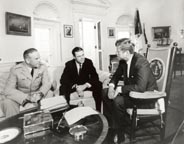1963 Vietnam Withdrawal Plans

Was there a Vietnam withdrawal plan in 1963? The answer is yes. What is at issue is not whether such plans had been created and initiated, but whether they were “serious,” i.e., whether the withdrawal would have continued in the face of a worsening situation in South Vietnam.
On October 11, 1963, Kennedy signed NSAM 263, initiating a withdrawal of 1,000 troops out of roughly 16,000 Americans stationed in Vietnam. Other documents, including planning documents from the spring of 1963, show that this was the first step in a planned complete withdrawal.
The controversy surrounds the fact that military reporting of the war effort in 1963 was decidedly rosy, and Kennedy made statements indicating that the positive outlook made withdrawal possible. Following the November deaths of South Vietnamese leader Ngo Dinh Diem and President Kennedy, reporting of the military situation in Vietnam took a turn for the worse. Does this then mean that Kennedy would have done as his successor LBJ did, and escalate the war in response?
John Newman’s landmark 1991 book JFK & Vietnam argues that Kennedy knew that the military reporting was skewed, and intended to withdraw anyway. Other analyses by Peter Dale Scott and James Galbraith (son of Kennedy advisor John Kenneth Galbraith), and recent books including one by no less than Robert McNamara himself, support this view. On the other side are many Vietnam historians and also social critic Noam Chomsky, whose Rethinking Camelot is largely a rebuttal of this view.





